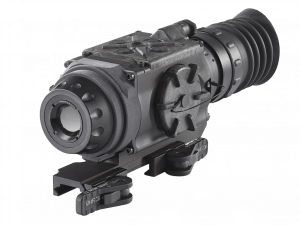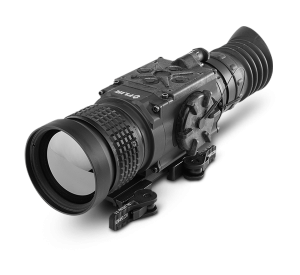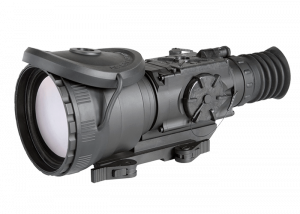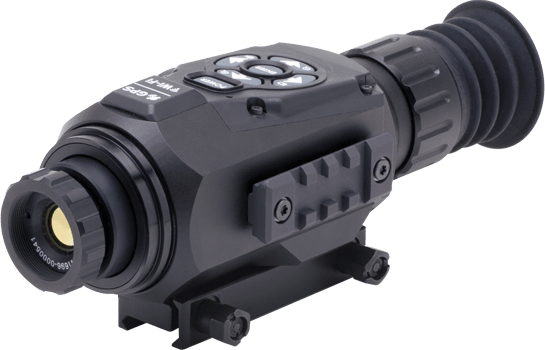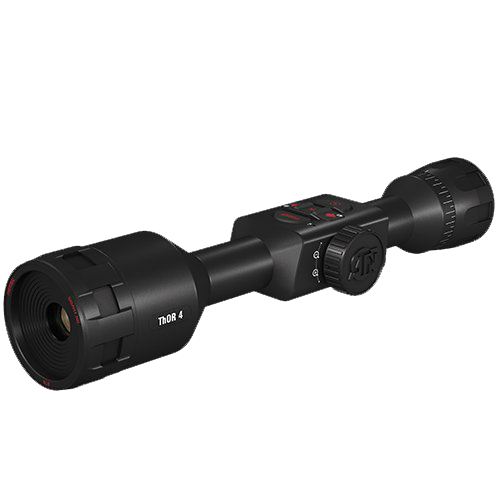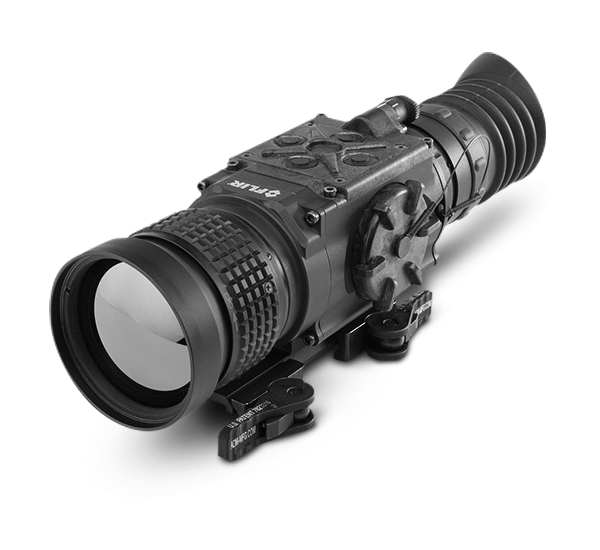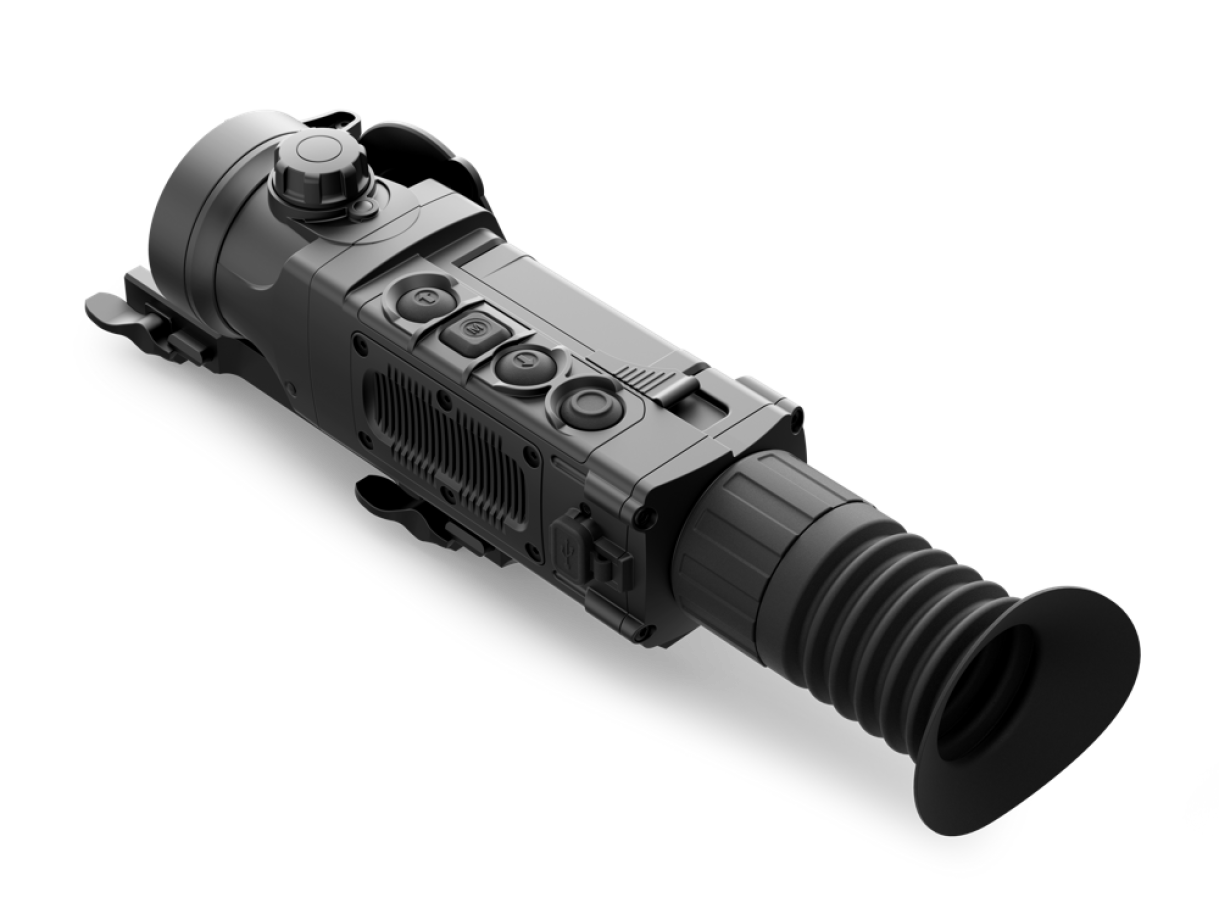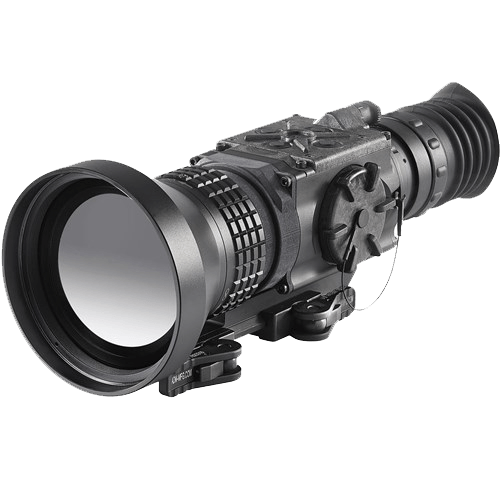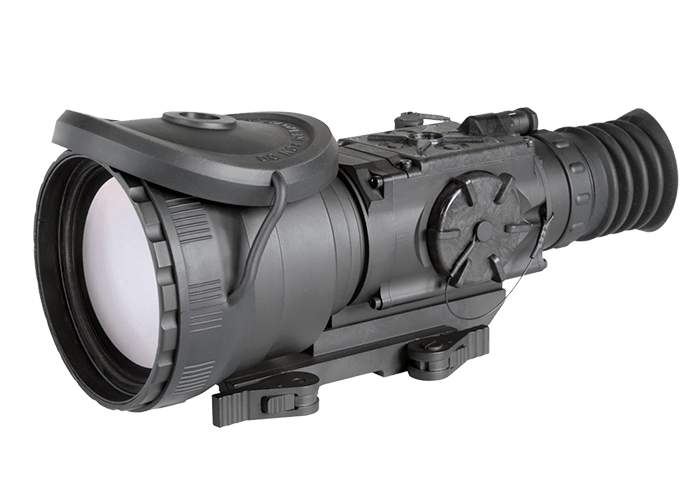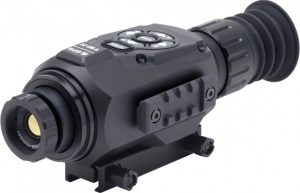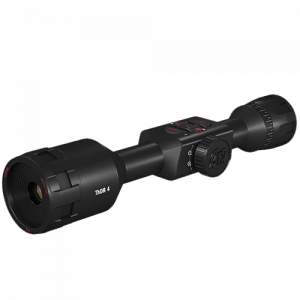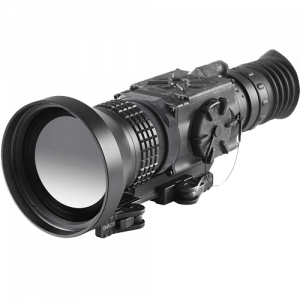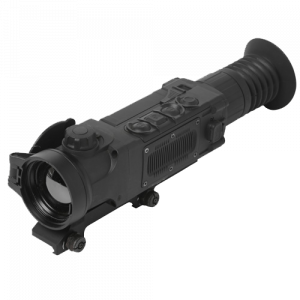
Humans have evolved significantly over the eons, but one area where evolution has not improved our abilities is our ability to see in the dark. While some species, such as felines, owls, opossums, and the alien in Predator have evolved to develop excellent night vision, humans have not.
Our ability to see is based on the light; this light can either be emitted by the object, such as a lamp or fire, or reflected by the object, including glass, water, or polished metal.
Our Personal Best Choice
In the darkness, or situations with limited light, our pupils are not able to recognize and process that light to enable us to see images. The species mentioned earlier have evolved with enlarged pupils, so they are able to see in conditions of limited light.
Given this physical constraint, humans have had to turn to technology to enhance their ability to see in conditions of near darkness.
So, to recap, the focus of this article will be on reviewing an even dozen thermal imaging scopes. Primary attention will be on their use in conjunction with a rifle, but they also have functionality as a night vision monocular, or hand-held device. As such, night vision devices can be used for hunting, wildlife watching, human surveillance, navigation, and detecting hidden objects.
Comparison Table
We’ve selected twelve of the best thermal imaging scopes from the Amazon web site, and will be reviewing them during the course of this article.
| Product | Best Features | Rating (No. of Reviews) | Price Range | View on Amazon |
|---|---|---|---|---|
|
3.8 out of 5 |
|||
|
3.7 out of 5 |
|||
|
3.7 out of 5 |
|||
|
4.0 out of 5 |
|||
|
3.8 out of 5 |
|||
|
3.5 out of 5 (5) |
|||
|
5.0 out of 5 |
|||
|
2.5 out of 5 |
|||
|
3.0 out of 5 |
|||
|
3.7 out of 5 |
|||
|
5 out of 5 |
|||
|
4.2 out of 5 |
Brief Introduction Into Night Vision Technology World
There are two different approaches to increasing the ability to see in the dark. The first is night vision technology, which involves amplification of the little light that is available, such as starlight or moonlight, through goggles, scopes, or night vision binoculars to make objects visible to the human eye.
The other approach is through the use of thermal technology, which does not use light, but rather heat, emitted as infrared rays, to make images visible. We will focus on thermal imaging in this article.
Below are examples of the type of images displayed by light amplification and thermal imaging:
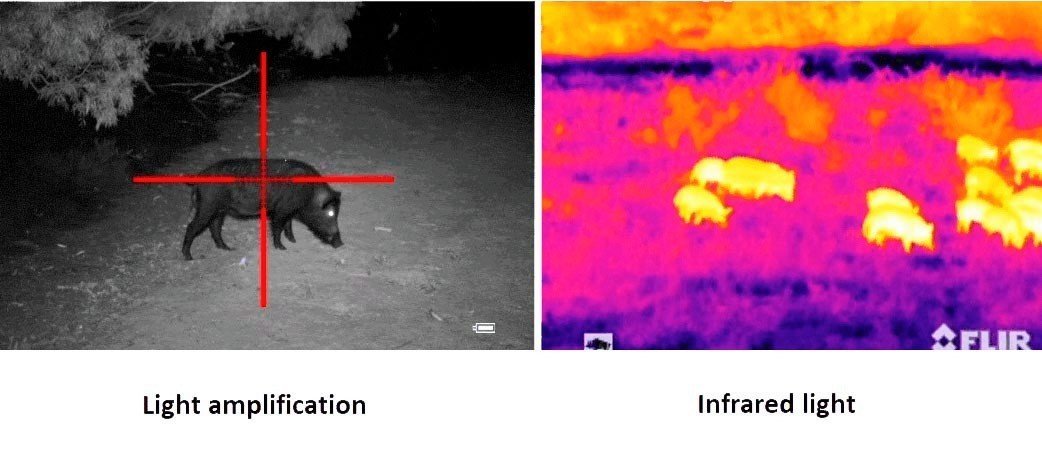
Thermal imaging devices have a military development history. During World War I, a Hungarian scientist developed the first thermal imaging sensors to help the British view incoming enemy aircraft.
The US Military and Texas Instruments worked together in 1947 to develop infrared line scanners, which have military applications even today (Wikipedia.com).
During the 1990s, the use of thermal imaging devices moved into the civilian marketplace. Technology changes and improvements made these devices much more affordable, and use in thermal cameras, binoculars, goggles, monoculars, and other areas developed.
Other major markets include medical diagnosis and imaging, environmental control systems, security, automotive guidance systems, and many more. Thermal night vision devices still maintain their presence in varied military applications and are used by fire and police in search and rescue missions.
One of the most common thermal imaging applications is thermal cameras. They have several residential and commercial applications, one of the most common being energy evaluations. As an example, if you point a thermal camera at a door or window, you should see very little color differentiation in the image if there is good insulation or weather sealing around the door or window. However, if there is a poor seal, you will see a different color “aura” around the door, which indicates that the air coming in is either hotter or colder than the door and the air already in the room.
A thermal imaging device has many similarities to a normal digital camera, but there are some key differences:
-
A digital camera will only detect visible light and can take photos and capture images because of that light.
-
A thermal device will detect infrared energy, which emanates from a different part of the light spectrum. As temperatures rise, more infrared energy is emitted, which is captured as black body radiation. This can be captured even in total darkness, which is an indication of why these devices are so important in search and rescue operations.
Because of the military-grade technology in several of these models, they are often not eligible for export. Some states also have bans on night vision devices, and these bans are typically related to a gun mounted NVDs. If there are questions about use or applicability in your state or jurisdiction, please check with the appropriate regulatory agency.
Buying Guide
As part of making the most informed buying decision, it’s good to make sure you have a complete understanding of all the available features and specifications on these night vision devices. Detailed comparisons may be necessary; the same specification may have wide levels of variation from one scope to the next.
After you go through this section, what we recommend as a next step is making a list of each of the features or specifications discussed here. Then go through and rate the importance of that feature for your intended application.
Typically, features will fall into three categories – must have (would not buy the product without it), nice to have (not mandatory, but a nice add on I would use), and, for want of a better term, bells and whistles (features I don’t need, and have no relevance to my planned usage of the scope).
When you’ve looked at it from that perspective, you should get a pretty good sense of where the best values are based on your needs and budget. At the end of this article, we will also weigh in with our opinions on the Best Overall Scope, Best Value Scope, and Best Performance Scope, plus name a runner-up in all three categories.
Before we move to the next part of this article, let’s take a quick look at how a night vision device is typically used. Most of these images can also be used as monoculars; a hand-held night vision unit. Primarily, however (and our focus here), is their use as a night vision scope when clipped to a rifle.
An example mounting is shown below:
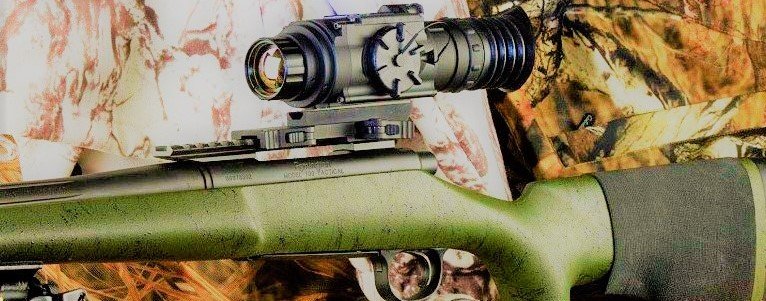
Best Thermal Imaging Scopes Review
ATN Thor HD384 1.25-5X
You start to wonder at some point if these are rifle thermal scopes or mini-computers. This one has lots of sophisticated electronics, including wi-fi rangefinder, ballistic calculator, and GPS. It’s compatible with both iOS and Android systems and has 1080 pixels high definition video recording and photos.
ATN Thor HD384 1.25-5X
Features and specifications:
- smooth zoom functionality, to let you gradually zoom in to your target, without losing it in your field of vision, as with step systems
- 384x288 pixels heat detection sensor
- several options available, including laser range finder, extended battery pack, and remote control
- recoil activated video and wi-fi streaming direct to your smartphone or tablet
Pros
- A good 3.8 rating, across a large cross-section, at a reasonable $1569 price
- Records to micro SD card, so memory can be expanded with larger GB card
- Almost 80% of reviews are 4 or 5 stars
- Multiple color palettes
Cons
- Several complaints about customer service and support
- Several reported issues with the software, and locking of the screens
ATN Thor 384 x 288
This is the next generation of the first scope that we reviewed. It has most of the same electronics as the first one but has added a more sensitive heat detector and an ultra-low power consumption feature, giving you up to 18 hours of battery life.
Pros
- A good overall rating, at the lower end of the price scale for our thermal scopes to be reviewed
- Good onboard data storage, and dual streaming to a separate device
- 1280 x 720 pixels display capability
Cons
- Customer service and support again savaged in several reviews
- Several complaints about the functionality of apps and software; few about the performance of the scope
Armasight Predator 366 – Best Value
This scope features three different zoom levels, and multiple palettes and reticle configurations. It’s water and fog-resistant, US-made and comes with a 3-year body and 10-year optics warranty. 640 x 480 pixels optics display, 60 HZ refresh rate.
Pros
- Lightweight at 1.4 pounds without batteries, yet durable for hunting and military applications
- Good field of view at 13o horizontal and 10o vertical, 25mm objective lens
- Good reviews for accuracy
Cons
- Battery life not good with standard equipment, but can be extended with the optional battery back
- No range finder capability
Flir Thermosight Pro PTS 233 – Best Overall
This is the last scope on the list under $2000 and comes with a 4.0-star rating (6 reviews). 60 HZ core refresh rate for clear, real-time imagery, including on-board recording (up to 2.5 hours) and image storage. It features an aluminum alloy body, yet a lightweight 1.4 pounds.
Pros
- Shot activated video recording
- Digital compass and inclinometer for precise target acquisition
- Fully digital for improved detection and classification, day or night operations
Cons
- One complaint about software freezing up during operation
- Poor user documentation
ATN Thor HD-640
This scope has an overall rating of 3.8 based on 52 customer reviews. As with other ATN thermal scopes, it comes with a broad range of electronic functionality, including a ballistic calculator, wi-fi, GPS, range finder, and compatibility with both iOS and Android functionality. The smooth zoom functionality lets you magnify to your target without losing visual sighting of it.
ATN Thor HD-640
Features and specifications:
-640 x 480 pixels thermal sensor
- high-resolution HD video and photo capability, with Recoil Activated Video and automatic streaming to your smart device
- accepts various size SD cards for additional onboard data storage
-1X, 2.5X, and 5X magnification, coupled with a 17mm objective lens
Pros
- Users claim animal identification at 250 yards using 5X magnification
- Optional laser range finder, battery pack, and remote control available
- Two-shot zeroing in functionality
Cons
- Low battery life. Users state battery pack is a necessity, not an option
- Some reviewers complained about grainy images
Flir ThermoSight Pro PTS533 – Best Value
This scope is similar to the PTS533 reviewed at #4 above, but with greater magnification capabilities. Like the other scope, this one has fully digitalized operation, for improved recognition and detection. It has a high-definition display, multiple color palettes, and on-board recording and storage for image capture and storage.
Flir Thermosight Pro PTS 533
Features and specifications:
- up to 2.5 hours of recording time
- magnification from 4X to 16X, combined with a 50mm objective lens for improved object clarity
- digital compass and inclinometer for more accurate targeting
- aluminum alloy construction for durability, yet only 1.78 pounds
Pros
- 4.5o x 3.5o field of view, not obscured by smoke, fog, rain, or darkness
- Recoil activated recording, multiple palettes, and reticles
- 60 Hz refresh rate
Cons
- Complaints logged about customer service and support
Pulsar Trail XQ – Best Overall
An impressive array of features and functionality, starting with a magnification of 2.7X – 10.8X combined with a 42mm objective lens and the ability to detect heat signatures of big-game at up to 1800 yards. Picture-in-picture feature provides a magnified image of the reticle at the top of the viewing screen for enhanced shooting accuracy. IOS and Android compatible.
Pulsar Trail XQ
Features and specifications:
- IPX-7 waterproof rating. Submersible in one meter of water for 30 minutes
- day or night operation, integrated video, and sound recording, up to 8-hour battery life
- 640 x 480 pixels display, 8 GB internal memory, operating range -13oF – 122oF
- 13 digital reticle options, 50 HZ refresh rate
Pros
- A nice blend of basic features with enhanced features vs. a lot of “bells and whistles”
- Perfect 5.0 rating (5 reviews on Amazon, and 15 on a different site)
- 8-hour rechargeable battery pack
- iOS and Android compatible, wireless remote control available
Cons
- 3-year warranty is relatively short for equipment in this price range
Armasight Zeus 640 2
Featuring 2X – 16X magnification, coupled with a 50mm objective lens, this scope provides crisp imagery in a variety of color palettes and reticle designs. 30 Hz refresh rate, 800 x 600 pixels display, and adjustable brightness controls enhance the image display. Four-hour battery life, with optional power pack available to increase it to 12 hours.
Pros
- E-zoom functionality from 1X to 4X without moving from point of aim
- Special contrast, sharpness, scene optimization, and gain controls to enhance imagery viewing
- Remote control wireless operation capability
Cons
- A surprisingly low 2.4 rating (3 reviews – one five stars and two one star on Amazon; 4×5 star reviews on OpticsPlanet.com)
- Both 1-star reviews are about the power failure and little customer support to deal with the issue
Flir Thermosight Pro PTS736
With this unit, we are moving further up the Flir Thermosight Pro ladder. This unit features big-time optics, with 6x – 24X magnification, married to a 75mm objective lens. Factor in an HD display, a 60 HZ refresh rate, and day-night operation to create a very useful scope for any application.
Pros
- Operating range -20oC to +50oC
- Digital compass and inclinometer for accurate range finding
- On-board video storage of 2.5 hours
Cons
- Fairly low 3.0-star rating. Found only three reviews between four different web sites
- Low battery life tends to dictate the purchase of external battery pack
- Low FOV – 3o x 2.5o
Pulsar Trail XP-50
While there is not a lot of information on the Amazon site, the manufacturer claims human-sized detection at 1970 yards – over one mile. The 640 x 480 pixels display, combined with multiple palettes and reticle options and magnification up to 12.8X makes this one very powerful, long-range scope.
Pulsar Trail XP-50
Features and specifications:
- built-in video recording with 8GB on-board storage
- 50 Hz refresh rate, 1.6X to 12.8X magnification capability
- android and iOS compatible, with wireless streaming capability (with separate Stream Vision app) and remote-control availability
- IPX-7 waterproof, -13oF - +122oF operating range for use in extreme conditions
Pros
- Picture in Picture functionality for a more detailed view of reticle sighting
- Various color and reticle options make for the highly contrasted display of images
- Smooth magnification changes so you don’t lose your targeted image
Cons
- Love-hate relationship. 75% 5-star reviews, 25% 1-star reviews.
- Two users complained of receiving used/refurbished equipment.
Trijicon Hunter Mark III
We’re rapidly moving up the price list now; this unit is a 50% premium over the Pulsar unit just above. But with that price, there is an almost complete lack of information on the Amazon site. Looking at other sites, this model is 2.5X35mm optics, with 640 x 480 pixels resolution and a 60 HZ refresh rate, reducible to 30HZ to save battery life. It has a 12o horizontal field of view and a view of 40.5 feet at 1000 yards.
Trijicon Hunter Mark III
Features and specifications:
- multiple reticles and palette options for enhanced image clarity
- lightweight aluminum housing, just over 2# weight, IPX-7 waterproof
- -40oF to +131oF operating range
- can be “stacked” with daytime scopes to increase magnification capability
Pros
- 5-star rating on Amazon site (2 reviews), no reviews found on two other sites
- Large lateral field of view
Cons
- Lack of user information
- Very little “standout” functionality over lower-priced units
Armasight by FLIR Zeus 640 3 – Best Value, Best Overall
This is the big brother of the Zeus 640 seen earlier (#8) and has a big brother price of almost $7000. It has the best optics of this group, with 3X to 24X magnification, and a large 75mm objective lens. The display is the latest generation 640 x 512 pixels OLED (organic light-emitting diode, as opposed to the more common LED technology) technology.
Pros
- The durable, highly functional unit, suitable from all applications from hunting to SWAT to the military to law enforcement
- Dual battery backs, plus operates on a single battery for one-hour emergency use
- Multiple palettes and reticle combinations, with various sharpness and clarity enhancing adjustments
Cons
- Only 4 ratings, two unfavorable. Customer support lacking.
- Price
Conclusion
Because of the wide range in prices in this group of clip on thermal scopes, we’re going to break them down into three groups.
The first group will be those priced under $2500, the second group those from $2500 – $5000, and the last group the two highest priced thermal scopes, the Zeus Pro 640 and the Hunter Mark III. For each of these groups, we’ll give you our recommendations on Best Value and Best Overall.
While we normally also select a runner-up for each category, it doesn’t really make sense here based on the small groupings. So, here is the summary information, all in one place:
Under $2500 category:
One quick comment – while we like both the ATN units for functionality, the customer service and support complaints were fairly consistent against both. If you are willing to risk that, they are both good value and functional units.
$2500 – $5000 category:
Over $5000 category:
If you are considering the purchase of a thermal imaging scope anytime soon, hopefully, this will give you some tips on selecting the unit that’s exactly right for you and your application. The commercial technology around thermal imaging is only a couple of decades old, and still in a state of flux.
Advancements in personal security and automotive applications for self-driving cars will enhance features while driving down costs. Be aware of these advances, as today’s hi-tech may well be tomorrow’s garage sale item.



